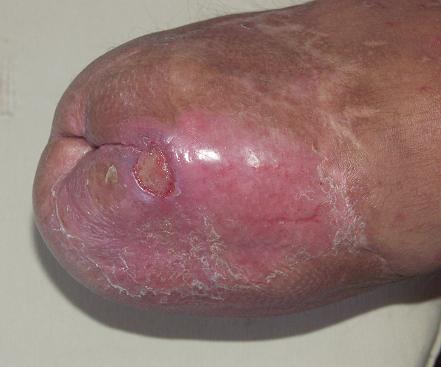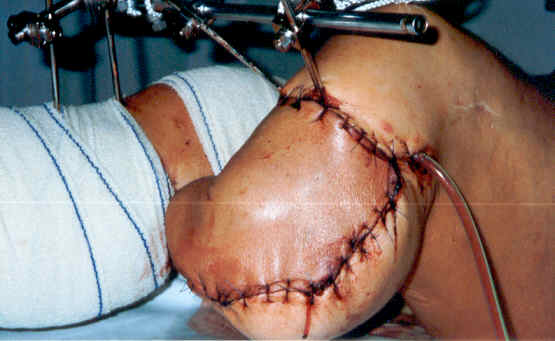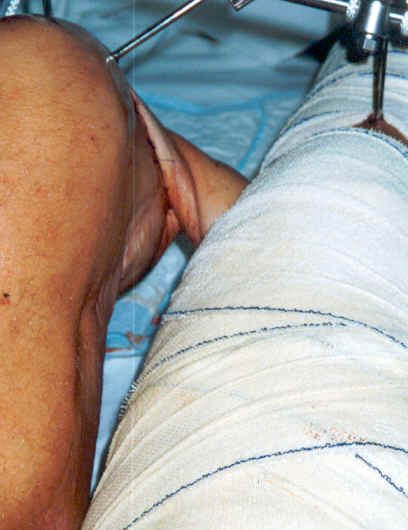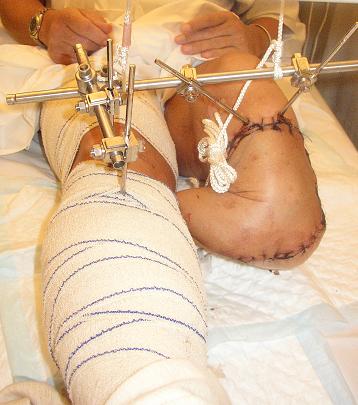Before the performing of this rather unknown operation I searched the internet in vain to get information. Couldn't find any information at all.
Now, after the surgery I'm able to tell about the transposition of a flap of skin through the linked tissue tranfer method. To report of the experiences and possible consequences afterwards I made an extensive story with pictures on this page.
 After examinations in hospitals at Amsterdam and Zwolle, September 2003 the descision was made for stump reconstruction surgery.
After examinations in hospitals at Amsterdam and Zwolle, September 2003 the descision was made for stump reconstruction surgery.
The wounds on the stump were unhealed for more than half a year. Time to take action to make walking with a prosthesis possible again.
Beginning of November 2003 I went to the Sofia Hospital at Zwolle. The plastic surgery consisted of: the old transplantation tissue should be changed for a better and thicker skinflap; tibia, wrinckles, scars and muscle tissue had to get reconstructed.
Linked tissue transfer method.
The initial transplanted skin on the stump was of a free skin graft type, attached after the amputation. The skin was removed from my upper leg. Disadvantage of this type of skin transfer is that the layer is very thin. Too thin to hold up against wearing a prosthesis and wouldn't grow stronger after time either.
Now a different technique would be used: the linked tissue tranfer method. A flap of skin is partly removed from the donor place, my right calf. The loose side of the flap is attached to the target area complete with its vasculair system: to the front of my stump.
After stitching, the legs are linked together by the flap. The intact vasculair system takes care of the bloodsupply of the flap on the stump from the donor place. The open part of my calf, where the flap has been taken off, is covered by free skin flaps from the upper leg.
This situation of linked legs takes about 3 to 4 weeks. Then the flap is cut loose and the stump has to take care of the blood circulation of the flap on its own.
 The big advantages of this methode: The transfered skin is of a complete thickness, with all layers attached. Not like a free grafted flap which is only one or two layers thick.
The big advantages of this methode: The transfered skin is of a complete thickness, with all layers attached. Not like a free grafted flap which is only one or two layers thick.
This is important for my stump. The new skin would be much stronger than what I had until now.
But the are several disadvantages as well.
The surgery is more drastic. The complete skin is removed from the donor place and covering has to be done with another skin tranfer, a free flap.
A stable fixation is needed between donor place and target area during 3-4 weeks.
The donor place will get damaged because of the removal of the complete skin. This will result in serious scars.
Three weeks on my back.
November 10th I was operated by plastic surgeon dr. Houpt. It was a shock when I woke from sedation and saw the ironwork which kept my legs fixated.
During surgery I had two kinds of anaesthesia: a total anaesthesia and local anaesthesia as well, intervenous in my spine. The latter would be continued for a longer time after surgery to keep me free of pain from the large operation wounds on my legs.
I experienced a strange sensation: with no sensibility at all in my lower limbs, I kept the sensation of phanthom pain.
For me that's prove of where phanthom feelings originate: in the brains, not in the limbs!
Unfortunately the local sedation was lost after two days. From that moment on I suffered the usual afterpains from surgery.
Another bizar experience was the feeling in my stump. Touching the skin flap attached to my stump, caused feeling on the spot where the skin originally came from. In my other leg, I mean. The feeling was transported through the skein which connected both legs; the nerves system still recognized the original place.
I had to stay in the hospitalbed for three weeks with both legs connected and hanging from a pulley over my bed.
The last week I got an infection of one of the fixation pins which was screwed into the tibia. The screw was removed and the fixation became unstable. From that moment on I was only able to move very little. Because of the constant pains from the wounds and infection I was kept on a personal morphine pump.
I could make heavenly trips whenever I wanted to.
Separation of the legs.
Three weeks after the operation the skin flap on my stump was considered to have sufficient bloodsupply from its new location. So the connected skein had done its job and would be cut. A terrific feeling to move my legs separately again.
When removing the bandages from my good right leg I was shocked. Looked as if dogs had eaten my calf for dinner!
I was prepared for this shock but nevertheless it was terrible to see.
Four weeks after the operation I was released from hospital. Mieke had to take care of the wounds every day. Because of the fixated position of my leg, hanging from a pulley, the muscles in my good right leg were stiffened.
Wasn't even able to stand on my leg anymore or walk with cruthes. My life was confined to only sitting in the wheelchair again.
Once more I asked the rehabilitation center "de Kastanjehof" for physiotherapic help. I got massages and walked between the bridge. It took me four weeks to regain my mobility of before the operation. This "pointed foot syndrome" is a disadvantage of the treatment that has to be considered on forehand.
In Januari the stump has to be operated upon for the final time to finish the skin flap on the stump. When the stitches are removed; the wounds are healed; and the stumpvolume and form is stable, I'm ready for my new prosthesis.
 After examinations in hospitals at Amsterdam and Zwolle, September 2003 the descision was made for stump reconstruction surgery.
After examinations in hospitals at Amsterdam and Zwolle, September 2003 the descision was made for stump reconstruction surgery.
 The big advantages of this methode: The transfered skin is of a complete thickness, with all layers attached. Not like a free grafted flap which is only one or two layers thick.
The big advantages of this methode: The transfered skin is of a complete thickness, with all layers attached. Not like a free grafted flap which is only one or two layers thick.